Chances are no one taught you about recycling and waste management in the Netherlands — and we don’t blame you!
Recycling and garbage disposal may not be the most exciting part of moving to a new country, but it’s essential to know if you want to live here comfortably.
Let op! Many Dutch cities will fine you big bucks if you don’t recycle correctly.
Whether you’re looking to live waste-free or want to do your part for the environment, this is the complete guide to recycling in the Netherlands.
- 🗑 Household waste and recycling in the Netherlands
- 💪 Become a recycling and trash pro — the Dutch way
- 🗞 Recycling paper in the Netherlands
- 🥤 Recycling plastic in the Netherlands
- 🍾 Recycling glass in the Netherlands
- 🔗 Recycling metal in the Netherlands
- 💻 Recycling electronics and appliances in the Netherlands
- 🛋 Recycling large items in the Netherlands (grofvuil)
- 👖 Getting rid of old clothes in the Netherlands
- 🌱 Composting in the Netherlands
- 💉 Responsible disposal of chemical waste and medicine in the Netherlands (klein chemisch afval)
- 🛻 Garbage collection and recycling stations in the Netherlands
- 💬 Common Dutch terms about recycling in the Netherlands
- Recycling in the Netherlands: Frequently Asked Questions
🗑 Household waste and recycling in the Netherlands
The majority of Dutchies sort and recycle their waste in one way or another — but what do you do with all the different types of waste?
Waste in the Netherlands is managed on a local government level, which means that it does differ a little depending on where you live. You should get in touch with your municipality to find out:
- the details on how recycling and waste management work where you live,
- all the important dates and schedules and
- if there are special ways of handling certain waste and recycling in your local area.
Sorting your waste
In the Netherlands, different kinds of waste need to be separated. Most municipalities require you to dispose of separately:
- Paper and cardboard waste 🗞
- Plastic, metal, and drink packaging (PMD) 🍸
- Green waste 🥗
- General waste 🗑
This means you have to sort it!
It’s typically easier to sort your waste as you go to avoid rooting around in your bin later. Your municipality might be kind enough to give you some small containers to sort your waste. Otherwise, you’ll need to buy them yourself.
Where do I dispose of my sorted waste?
There are two ways to dispose of your waste and recycling in the Netherlands. In most areas, you must deposit your waste and recycling in shared containers.
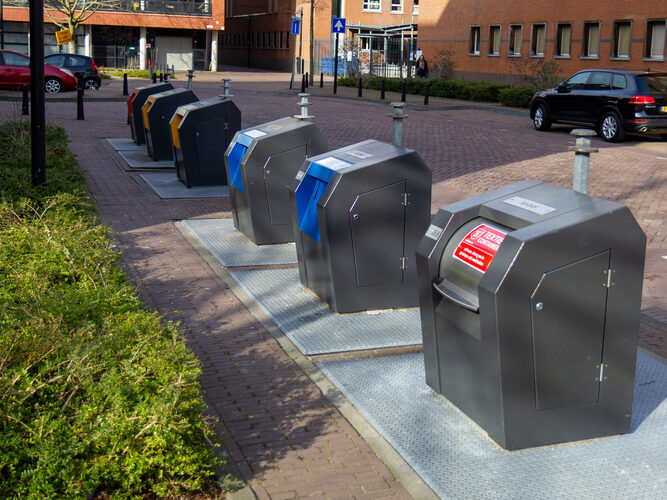
Municipalities usually have containers for waste, paper, glass, and plastic, metal, and drink packaging (PMD). These communal containers look like large metal boxes.
You lift the lid to put your waste or recycling in the correct container, and it falls into a huge underground storage unit.
The municipality regularly empties these containers, so there’s no need to worry about timing your recycling days or remembering to put a wheelie bin out.
TIP: Your municipality’s website will have a map of all recycling container locations and which materials you can recycle there.
If you live outside of a city, your household may have been given two to four containers for waste and recycling. The municipality will come a few times a week to empty the containers.
Recyclable vs. non-recyclable waste: what happens?
Once your recycling is sorted, the materials are usually recycled in the Netherlands or elsewhere in Europe. Non-recyclable waste goes to an incinerator or a landfill.
However, these incinerators produce electricity that is put back into the power grid for hundreds of thousands of Dutch homes.
Looking ahead, the Netherlands aims to become a completely waste-free country by 2050. This means they want to:
- reduce the number of raw materials used to make products,
- reuse as many raw materials as possible, and
- reduce waste from using products.
Hopefully, this will reduce the need for incinerators or landfills in the future!

💪 Become a recycling and trash pro — the Dutch way
Now, here’s where your part comes in. It’ll get some taking used to, but managing your waste won’t be too complicated once you get the hang of it.
🗞 Recycling paper in the Netherlands
Most paper (papier) and cardboard can be recycled in the Netherlands as well as food packaging, cardboard, and parcel packaging can all get a new life. Hoera! 🎉
But if your paper is soiled, for example, it has oil, paint, dirt, or some other grime on it, you’ll have to toss it in with your general waste.
Depending on how busy your city is, municipalities empty the recycling bins a few times a week or once every one or two weeks. 📄
If a recycling point is full, it’s best to bring your recycling back home and wait a few days for the municipality to empty the bins.
⚠️ Warning: You might be tempted to leave your recycling in a pile near the bins instead, especially if other people have already. Not only is this bad for the environment, but some municipalities also search through this rubbish, find the litterers by looking at the shipping labels on boxes and envelopes, and then send them a hefty fine.
What goes in the paper bins (papierbakken)?
✅ Newspapers, food packaging, cardboard, mail, envelopes, paper packaging, paper wrappers
❌ Shop receipts of any kind, any soiled paper material, and other dirty paper products like food napkins, used paper plates, greasy pizza boxes, etc.
🥤 Recycling plastic in the Netherlands
Plastic recycling can be a tricky business. No one wants to be responsible for the ocean plastic problem or hurting adorable sea turtles, but not all plastic can be recycled.
To figure out if you can recycle your plastic waste, you can usually check the packaging to see if it’s recyclable. Plastic can be sorted with metal and drink packaging when you’re recycling waste.
But before you chuck that piece of plastic in the bin, make sure you clean any leftover crumbs from the waste you want to recycle. Otherwise, it can contaminate whole loads of recycling, forcing it into landfills or to be incinerated instead.
It’s also important to know that you can get a bit of money back for returning some types of plastic bottles to your local Dutch supermarket.
This is called statiegeld (deposit money). Most beer (by the crate, bottle or can), plastic soda bottles and cans, like Coca-Cola or water, will get you anywhere from €0.10 to €0.25, depending on the size of the bottle.
Using a bottle return system (statiegeld) in the Netherlands
If you’ve never used the bottle return system in the Netherlands, fear not! Here’s how it works.
Most supermarkets have a machine in the store to deposit both plastic bottles and beer bottles/crates. If you’re unsure where the machine is, you can ask a supermarket employee to point it out for you.
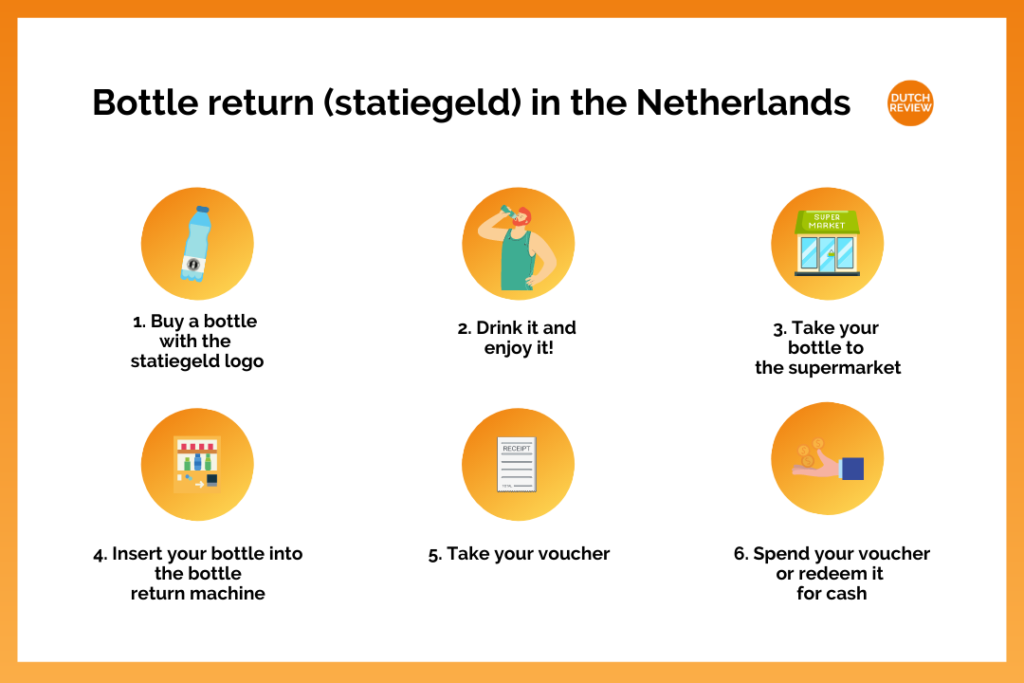
Once you’ve finished putting all of your recyclables in, you get a voucher back instead of actual cash. You can scan this voucher to get a discount on your groceries, or you can ask for it back in cash at the service desk in the supermarket.
This is definitely a service you should use, especially because you can get money back, all the while lessening plastic pollution. Seems like a win-win in our books!
Be aware that the supermarket has to sell the brand you are returning. For example, you can’t return a Coca-Cola bottle to Lidl because they don’t sell Coca-Cola there.
READ MORE | The ultimate guide to the cheapest supermarkets in the Netherlands
You can’t return all bottles for statiegeld.

It’s important to recycle properly because plastic pollution is an ongoing issue in the Netherlands, but the country deals with it in a few interesting ways.
For example, plastic fishing in Amsterdam has become a popular way of handling plastic in the city. But of course, there’s always room for improvement.
What goes in the plastic bins (plasticbakken)?
✅ Plastic packaging, some food packaging, plastic wrappers, etc.
❌ Cling film/saran wrap, plastic tape, bottles for cleaning products (like bleach and toilet cleaner), foil-like food packaging (like chip bags), etc.
🍾 Recycling glass in the Netherlands
Glass from food and drink packaging (such as bottles and jars) are the only types of glass you can recycle. Other glass products, like tableware and cookware, are recycled differently.
Sometimes, you have to separate the glass into coloured (bont) or white (wit) glass, and some cities even divide green (groen) and brown (bruin) glass. 🥛
If you have to recycle glass separately, the municipality will clearly label the recycling bins with bont, wit, bruin, or groen glass.
Otherwise, the recycling bins will just say “glas”, and you can put any food or drink glass packaging in.
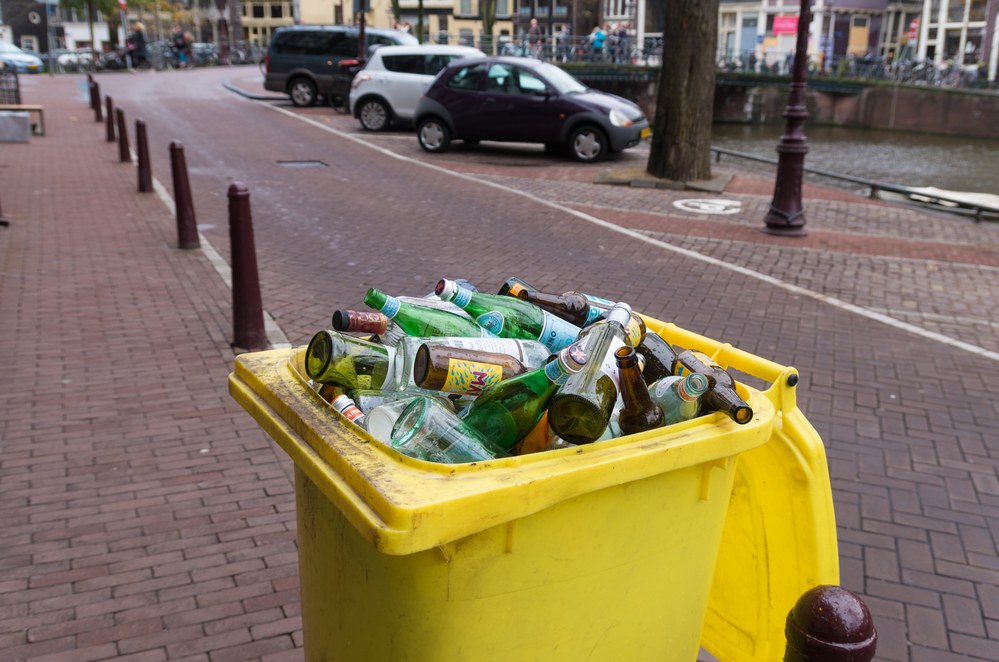
You can also get statiegeld for glass, particularly from beer bottles. If you drink beer as much as Dutchies do, you can turn in your beer bottles by the crate or half-crate, but you can also deposit single bottles.
Glass bottles usually have “statiegeld” written somewhere on the label along with how much money you get back so you can find out which of your glass recycling can be deposited.
What goes in the glass bins (glasbakken)?
✅ Food jars, sauce bottles, etc. You can leave lids and covers on the jars and bottles.
❌ Light bulbs, glass cookware, eyeglasses, glass from windows, etc.
🔗 Recycling metal in the Netherlands
Metal recyclables include mostly food packaging such as drink cans, food tins, and aluminium foil, which can also be put with plastic and drink packaging.
If you want to recycle scrap metal or bulkier metal waste, you will have to dispose of it as grofvuil (more on that later).
What counts as metal recyclables?
✅ Metal drink cans, food tins and cans, aluminium foil
❌ Any other metal waste
💻 Recycling electronics and appliances in the Netherlands
This type of waste is not as common as the other types, but leave it to the Dutch to recycle it.
You can usually drop off electronic and small household appliances at some recycling points along with paper, PMD, glass, and restafval bins.
Check your municipality’s website to see which recycling points have a bin for electronics and appliances.
If you have an old phone that doesn’t work anymore, you can dispose of it in one of these recycling bins or try to recycle it at your local electronics stores like MediaMarkt.
If there’s nothing nearby, you can drop off electronics and appliances at the general waste drop-off centre in your municipality.
What counts as a small appliance?
✅ Mobile phones, cables, light bulbs, appliances like lamps, headphones etc.
❌ TVs, laptops, PCs, monitors (these definitely wouldn’t fit in the recycling bins)
🛋 Recycling large items in the Netherlands (grofvuil)
We know IKEA is everyone’s go-to furniture store (mostly because it’s the only furniture you can transport around here). Still, it’s not every day you have to get rid of an old couch to make room for the new.
That brings us to the two ways to handle large waste: dispose or donate.
Donating large waste
If your large items are still in good condition, consider bringing them to a charity or a second-hand shop (called the kringloop in the Netherlands). Donating is a great idea, especially if you’re looking to reduce your overall waste.
It’s such a great idea that some kringlopen will even come to pick up your old stuff for free! This does vary per store, so make sure to check what options are available with your local kringloop.
Disposing of large waste
If your large items are beyond repair, they can often be picked up by the municipality’s waste management and collection department by making an appointment through the municipality.
The municipality usually does these pick-ups for free under a certain size and weight. Not all municipalities offer this pick-up service, so it’s best to check what the municipality can do for you.
TIP: It’s not necessarily legal, but if you put a large item on your sidewalk for a few hours with a little “gratis” sign on it, someone else might just claim the item for you. Just make sure to remove it if no one takes it!
If you have large items that don’t fit the regulations, you can make an appointment to bring them to your local waste management station. You can check the exact regulations in your municipality through their website.
What counts as grofvuil (large waste)?
✅ Mattresses, old furniture like couches, TVs, ovens, etc. 🛋
❌ Small household items and appliances like lamps and light bulbs
👖 Getting rid of old clothes in the Netherlands
If you’ve just come back from a shopping haul or are in desperate need of a spring clean, you might want to consider recycling or donating clothes to make room in your closet.
Donating clothes in the Netherlands
If you still have wearable clothes but don’t want to keep them, consider donating them to a kringloop or thrift shop. There’s always someone out there who’s thrifting for clothes or wants to buy second-hand. 👗
The only real requirement for donating clothes is that they’re in good condition (no holes, no tattered edges, little to no discolouration of the fabric, unless it’s part of the style) and that they’re clean when you donate them. 🧺
To donate clothes, you can talk to the kringloop or thrift shop employees about how to drop off your recyclables. The shops will check the quality of the clothes and see whether they can take your clothes and resell them.
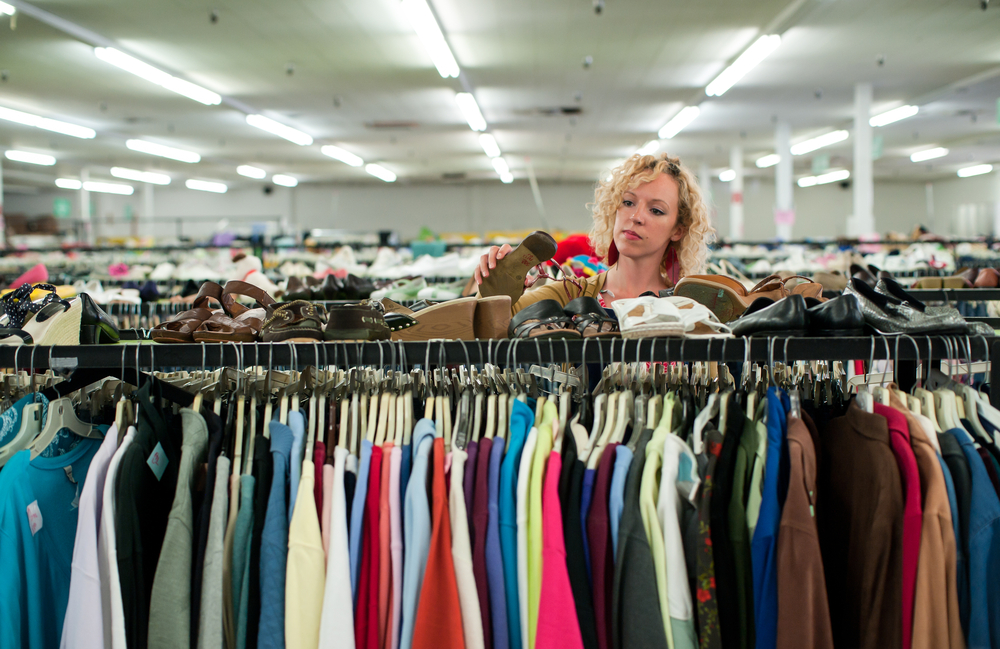
If the shops decide they can’t resell your clothing for whatever reason, you can recycle them at a recycling point, the same way you would recycle paper or glass.
Recycling clothes in the Netherlands
You can recycle clothes that are both in good or bad condition — for example, you could recycle a pair of trousers that just aren’t quite your style but are relatively new and clean. It’s also possible to recycle clothes that can’t be worn anymore, for example:
- If they have holes
- If the fabric is tattered or worn
- Scrap clothing
- Scrap cloth or textiles
The municipality usually puts recycling bins for clothes and other textiles (textielbak) near other communal recycling bins. Still, these bins are not as common as the other types of waste.
You won’t always find them at your closest recycling point, so it’s best to check your municipality website to find where these bins are exactly.
Your clothes have to be clean (no oil or paint stains) and dry to put in the recycling bins. You can put clothes into a plastic bag and pack them tightly to stay clean.
You can also tie together shoes and put them in the bag together with clothes.
What goes in the textielbak (textile bin)?
✅ Clean clothes (even if they are worn or torn), hats, scarves, purses, belts, shoes (tied together), towels and washcloths, tablecloths, blankets, and stuffed toys.
❌ Badly stained or wet clothes, carpets/rugs, duvets, pillows, and mattresses.
🌱 Composting in the Netherlands
Some households get groenbakjes (green bins) used for composting biodegradable materials (materials that bacteria and other living organisms can decompose to avoid pollution). All of these materials are called “green waste”.
Groenbakjes is an option but not a necessity. You can check up with your municipality’s website to see if you can get a groenbakje where you live. If you don’t have a groenbakje, you can put your food and other waste with restafval (general waste).
What goes in a groenbak (green bin)?
✅ Vegetables, fruits, peelings, leftover cooked food, fish and meat leftovers (with bones), egg and nut shells, cooking fat, tea bags, coffee filters and grounds, garden waste like branches, leaves, weeds, flowers, straw
❌ Cat litter, baby diapers, drink or plastic packaging, large pieces of wood or branches, sand, fireplace ash, pet hair, vacuum cleaner contents
💉 Responsible disposal of chemical waste and medicine in the Netherlands (klein chemisch afval)
Small chemical waste (klein chemisch afval or KCA) also needs to be disposed of properly, which includes waste like medicine and chemicals. This refers to paint, paint thinners, toners, printer cartridges, turpentine, and cleaning agents. ⚠️
You cannot throw these away with the restafval. Instead, dispose of chemical waste at the waste management and collection station closest to your house.
For medicine, you can return outdated prescriptions and over-the-counter medicines, like pills, cough medicines, and antibiotic ointments, to a pharmacy counter for proper disposal.
If you’re unsure about what’s disposable, check your local municipality’s regulations.
Disposing of batteries in the Netherlands
Batteries get a bit of special treatment because they’re a pretty common recyclable but full of chemicals. Luckily, it’s just as easy to recycle as paper and plastic.
Most supermarkets and some stores have space for collecting old batteries in a batterijenbak (battery box), which is usually red or blue. You can sort batteries with the rest of your chemical waste, but this might be a more convenient way to recycle them!
What chemical waste and medicines can be responsibly disposed of?
✅ Batteries, pesticides/insecticides, medicines, DIY materials like paint, thinners, brush cleaner, printer cartridges
🛻 Garbage collection and recycling stations in the Netherlands
Municipalities have garbage and recycling collectors who come every week either to empty the communal bins or to pick up waste from individual households.
If you live in a bigger city, it’s more likely you’ll have to bring your waste and recycling to the communal bins. The bins are regularly emptied, so you don’t have to stress about pick-up schedules.

In the less built-up areas, waste and recycling collectors might have specific pick-up days for different waste types. It’s important to check with your neighbours or your municipality so you can leave the right type of waste out on the right day.
💬 Common Dutch terms about recycling in the Netherlands
Whew, that was a lot of information. If you’ve lost track, here’s a list of common Dutch terms when it comes to recycling and waste management that might come in handy later.
| Dutch | English | Meaning |
| Afval | Waste | All waste |
| Restafval | Residual waste | Non-recyclable waste |
| Papierbak | Paper bin | Bin to recycle paper |
| Plastiekverpakkingen | Plastic packaging | Any plastic products used for packaging |
| Glasbak | Glass bin | Bin to recycle glass |
| Batterijenbak | Battery bin | Bin to recycle batteries |
| Groenbak | Green bin | Bin for compostable materials |
| Textielbak | Textiles bin | Bin to recycle textiles and clothes |
| Grofvuil | Bulky waste | Large items to be disposed of |
| Statiegeld | Deposit | A deposit paid on eligible bottles and cans that you receive back when the items are returned |
And that’s everything you need to know about recycling and waste management in the Netherlands! Do you have any recycling tips for newcomers to the Netherlands?
Recycling in the Netherlands: Frequently Asked Questions
Do I get money for returning bottles in the Netherlands?
In short, yes! You can recycle plastic and glass bottles like soda and beer bottles, but not all will give you back the money.
For example, a Coca-Cola or Heineken bottle will get you some money back, but a super-niche Belgian craft beer probably won’t.
You can check whether bottles give you statiegeld on the packaging themselves, look online, or check with supermarkets.
Can I recycle batteries in the Netherlands?
Yes, you can! Most Dutch supermarkets have a box where you can drop off your empty batteries safely. They’re usually labelled, and if you can’t find one, ask a supermarket employee to direct you.
Where can I recycle electronics in the Netherlands?
Each municipality has its way of recycling small appliances, so it’s best to check your municipality’s website. In general, the municipality has a few recycling bins for electronics which you can find by looking on their website.
Is there an option to dispose of waste privately in the Netherlands?
Each municipality has its way of recycling small appliances, so it’s best to check your municipality’s website. In general, the municipality has a few recycling bins for electronics which you can find by looking on their website.
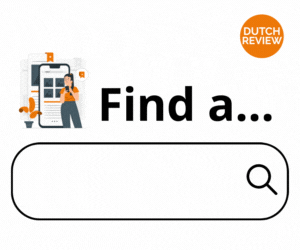
can recycle EPDM weather-strip/ car window seal in the Netherlands?
I’m sorry but this post is wrong in so many levels! You can’t write about Dutch recycling because each municipality has a totally different system. Even within a municipality there are many different regimes. You may be able to recycle something in one neighborhood, but not in another. For instance shop receipts can go in paper in many places, while plastic isn’t recycled at all in others. There are even plenty neighborhoods where trash isn’t sorted or recycled at all. It all depends on where you live. You can’t make a page like this, covering he entire country. That’s just not the way it works in the Netherlands.
In some part of the giving the product 2nd life is totally bull-shit in the netherlands. Lately, we were clearing the house of my mother-in-law who passed away last year, she left lots of good stuffs behind in the house and we tried to give it away, the so-called kringloop said that they don’t accept it because they cannot sell it. For example, we’ve electric bed that was working perfectly, the cupboard that still in perfect shape which were not from ikea and we’ve to demolish them to throw it as a rubbish. It is just a hype word that people used nowadays.